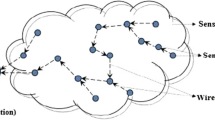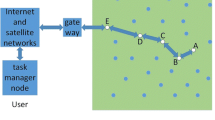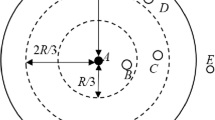Abstract
Aiming at the problem that the DV-HOP and MDS-MAP localization algorithms have large positioning errors when applied in the concave region, this paper proposes a fusion algorithm DV-MDS-SA localization algorithm. Firstly, the estimated distance from non-ranging unknown node to anchor node is obtained by DV hop algorithm. Then, the DV-Hop localization algorithm is used to multiply the shortest number of nodes by the single hop correction value to obtain the shortest distance between nodes. The shortest distance is applied to the MDS-MAP algorithm to find the estimated position of a group of non-ranging unknown nodes. Finally, in order to obtain more accurate positioning results in the concave area, the simulated annealing algorithm is used to optimize the estimated position of the unknown node obtained in the previous step, so as to further reduce the positioning error. The simulation results show that the DV-MDS-SA positioning algorithm proposed in this paper can obtain more accurate positioning results under the same network environment and has high application value.







Similar content being viewed by others
References
Zhao, Z., Wang, X., & Wang, T. (2018). A novel measurement data classification algorithm based on SVM for tracking closely spaced targets. IEEE Transaction on Instrumentation Measurement, 99, 1–12.
Wei, Q., Zhong, D., & Han, J. (2014). Improved localisation method based on multi-hop distance unbiased estimation. IET Communication, 8(16), 2797–2804.
Magowe, K., Giorgetti, A., Kandeepan, S., & Yu, X. (2018). Accurate analysis of weighted centroid localization. IEEE Transactions on Cognitive Communications and Networking, 5(1), 153–164
Alıcı, G., Jagielski, R., Şekercioğlu, Y. A., & Shirinzadeh, B. (2006). Prediction of geometric errors of robot manipulators with Particle Swarm Optimisation method. Robotics on Automatic System, 54(12), 956–966.
Wang, Z., Zhang, B., Wang, X., Jin, X., & Bai, Y. (2018). Improvements of multihop localization algorithm for wireless sensor networks. IEEE System Journal, 99, 1–12.
Tang, W., & Zhou, L. (2015). An improved APIT localization algorithm based on triangle-circumcircle cover. Chinese Journal of Sensor Actuators, 28, 21.
Liu, W., Wang, D., Jiang, H., Liu, W., & Wang, C. (2012). Approximate convex decomposition based localization in wireless sensor networks. In Proceedings IEEE INFOCOM Orlando, USA, March 25-30
Yu, G. J., & Wang, S. C. (2008). A hierarchical MDS-based localization algorithm for wireless sensor networks. In Proceedings of the 22nd International Conference on Advanced Information Networking and Applications, Gino-Wan, Japan, March 25-28,
Vivekanandan, V., & Wong, V. W. (2007). Concentric anchor beacon localization algorithm for wireless sensor networks. IEEE Transaction on Vehicle Technology, 56(5), 2733–2744.
Han, S., Lee, S., Lee, S., Park, J., & Park, S. (2010). Node distribution-based localization for large-scale wireless sensor networks. Wireless Network, 16(5), 1389–1406.
Wang, H. A. (2017). New WSNs localization based on improved fruit flies optimization algorithm. In Proceedings of the 2nd International Conference on Computer Engineering, Information Science and Application Technology (ICCIA 2017), Wuhan, China, July 8-9
Wen, W., Wen, X., Yuan, L., & Xu, H. (2018). Range-free localization using expected hop progress in anisotropic wireless sensor networks. Eurasian Journal of Wireless Communication 2018(1), 299
Chen, K., Wang, Z. H., Lin, M., & Yu, M. (2011). An improved DV-Hop localization algorithm for wireless sensor networks. Chinese Journal of Sensor Actuators, E91-A(8), 2232–2236.
Zhang, B., Yu, F., & Zhang, Z. (2009). Collaborative localization algorithm for wireless sensor networks using mobile anchors. Integrated Research Output, 1, 309–312.
Abdelhadi, M., & Anan, M. (2012). A three-dimensional localization algorithm for wireless sensor networks using artificial neural networks. In IEEE 9th International Conference on Mobile Ad-Hoc and Sensor Systems (MASS 2012), Las Vegas, USA, October 8-11,
Yuan, Y., Liang, C., Kaneko, M., Chen, X., & Hogrefe, D. (2018). Topology control for energy-efficient localization in mobile underwater sensor networks using Stackelberg game. IEEE Transaction on Vehicle Technology, 68(2), 1487–1500.
Bai, Y., Li, C. M., & Xue, Y. (2013). A centroid localization algorithm for wireless sensor networks based on RSSI. Applied Mechanics and Materials, 303, 197–200
Sotenga, P. Z., Djouani, K., Kurien, A. M., & Mwila, M. (2018). Implementation of an indoor localisation algorithm for internet of things. Future Generation of Computation System 2018:S0167739-17320307
Liu, J., Wang, W., & Shang, Y. (2012). An improving localization algorithm for wireless sensor networks based on DV-Hop. In Proceedings of the 2012 International Conference on Measurement, Harbin, China, 18-20 May 2012
Li, J., & Chen, M. (2016). Multiobjective topology optimization based on mapping matrix and NSGA-II for switched industrial Internet of Things. IEEE Internet Things, 3(6), 1235–1245
Stojkoska, B. R., Kirandziska, V., & Improved. (2013). MDS-based algorithm for nodes localization in wireless sensor networks. In EUROCON IEEE. Zagreb, Croatia, 1-4 July 2013
Akber, A. K., Vinod, K., & Musheer, A. (2019). An elliptic curve cryptography based mutual authentication scheme for smart grid communications using biometric approach. Journal of King Saud University - Computer and Information Sciences (prepublish)
Kumar, V., Ahmad, M., Kumari, A., Kumari, S., Khan, M. K., & SEBAP. (2021). A secure and efficient biometric-assisted authentication protocol using ECC for vehicular cloud computing. International Journal of Communication Systems 34(2), e4103
Khan, A. A., Kumar, V., Ahmad, M., & Rana, S. L. A. K. A. F. (2021). Lightweight authentication and key agreement framework for smart grid network. Journal of Systems Architecture, 116, 102053.
Acknowledgements
This article was supported by the Scientific and Technological Project of Henan Province under Grant (No.: 202102210145).
Author information
Authors and Affiliations
Corresponding author
Additional information
Publisher’s Note
Springer Nature remains neutral with regard to jurisdictional claims in published maps and institutional affiliations.
Rights and permissions
About this article
Cite this article
Tian, E. A non-ranging Fusion Location Algorithm for Concave Regions. Wireless Pers Commun 124, 2537–2551 (2022). https://doi.org/10.1007/s11277-022-09477-5
Accepted:
Published:
Issue Date:
DOI: https://doi.org/10.1007/s11277-022-09477-5




